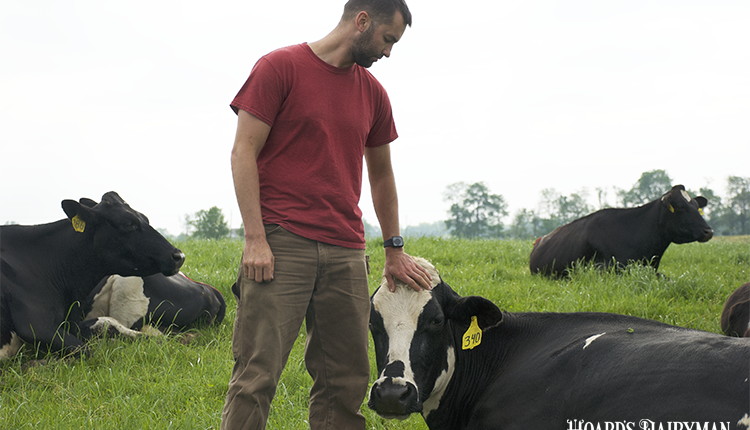
The National Dairy Farmers Assuring Responsible Management (FARM) Program launched its latest Animal Care Program standards on July 1, continuing to provide science-based guidelines for the industry and best on-farm animal care practices.
FARM Animal Care is the oldest and most widely participated in segment of the FARM Program. As a foundational pillar, the program provides the industry with a unified approach in demonstrating its commitment to animal care. The Version 5 standards will be in effect through June 30, 2027, after the previous iteration was extended 18 months because of the COVID-19 pandemic.
The Version 5 review process produced refinements and clarifications that improve FARM Animal Care evaluation consistency. The primary areas that the governance committees reviewed focused on pain management, fitness for transport in all age classes, disease treatment and euthanasia protocols, handling and stockmanship, animal-based outcomes, and calf management.
Regular reviews for all
Review and revisions of program standards are conducted every three years to make sure the program is being implemented with integrity and maintains relevancy with the latest science and best management practices for dairy producers of all sizes.
Dairy farmers have a strong voice in every step of the process. Standards are reviewed by the FARM Farmer Advisory Council (100% made up of active dairy farmers) and its Animal Care Task Force (which is 28% farmers), who propose considerations for revisions to the National Milk Producers Federation (NMPF) Animal Health and Well-Being Committee that consists of 56% farmers. A final proposal is presented to NMPF’s board of directors, 67% of which are farmers, and they provide final approval on any revisions put forward by the Animal Health and Well-Being Committee to the program.
Version 5 updated standards
Changes found in FARM Animal Care Version 5 include the following:
Locomotion
Version 4 standard: 5% or less of lactating cows observed with a score of 3 on the FARM locomotion scorecard.
Version 5 standard: Maintain the above standard in addition to implementing a new standard for moderate lameness that 15% or less of lactating cows are observed with a score of 2 on the FARM locomotion scorecard.
Pain mitigation for disbudding
Version 4 standard: Pain mitigation for disbudding provided.
Version 5 standard: Maintain the above standard, but the timeline for correction if the standard is not met has been shortened from three years to a maximum of nine months.
Disbudding method
Version 4 standard: Calves should be disbudded, but there was no standard method for disbudding prescribed in the standard.
Version 5 standard: Calves should be disbudded with caustic paste or cautery, per American Association of Bovine Practitioners (AABP) guidelines.
Colostrum feeding
Version 4 standard: Preweaned calf protocols and practices must demonstrate that preweaned calves are provided a sufficient quality and quantity of colostrum or a colostrum replacer within six hours after birth, even if immediately transported off the farm.
Version 5 standard: Maintain the above standard, with more clearly defined expectations regarding quality and quantity. Preweaned calf protocols and practices must demonstrate that preweaned calves are provided sufficient quality (by visual observation or a colostrometer, for example), and quantity of colostrum or a colostrum replacer (10% of birth weight), or there must be evidence of successful transfer of passive immunity and colostrum must be provided within six hours after birth, even if immediately transported off the farm.
Continuing education
Version 4 standard: Job-specific continuing education is available for family employees with animal care responsibilities in stockmanship/handling, preweaned calf care, nonambulatory animals, euthanasia, and determining animals that are fit for transport.
Version 5 standard: Maintain the above standard, but the timeline for correction if the standard is not met has been shortened from three years to a maximum of nine months.
Euthanasia
Version 4 standard: Euthanasia protocols and practices are in place and follow AABP guidelines.
Version 5 standard: Maintain the above standard, but euthanasia protocols and practices must demonstrate a method for confirmation of death and have a primary and secondary individual identified for conducting euthanasia.
Prepare for the future
To aid in the transition to Version 5 this summer, the FARM Program has created a FARM Animal Care Evaluation Preparation Guide that provides program expectations for all involved parties under the updated standards. It identifies the animal and facility observations evaluated, noting standards that have associated accountability measures if not met and outlined time frames to achieve compliance.
Farmers should reach out to their cooperative or processor evaluator for any preparation assistance ahead of their evaluation. Producers are also welcome to provide feedback after evaluations are completed by submitting a feedback form on the nationaldairyfarm.com website, via the link provided in their electronic evaluation, or by sending an email to dairyfarm@nmpf.org.
Training for evaluators on Version 5 standards began in February to prepare for evaluations starting this summer. FARM Program evaluators, who must meet outlined prerequisites including on-farm dairy experience, undergo in-person certification and annual calibration to conduct second party Animal Care evaluations on behalf of participating FARM cooperatives and processors. Evaluators work alongside dairy producers to identify strengths and outline areas of improvement for on-farm management practices.
“After two years of farmer conversations and committee and council meetings, these standards will continue to serve in reinforcing the dairy industry’s commitment to promoting animal welfare,” said FARM’s Senior Director of Animal Care Beverly Hampton Phifer.
For more information on FARM Animal Care Version 5 and its development, along with other guidelines and producer resources, visit the National FARM Program website at nationaldairyfarm.com.










